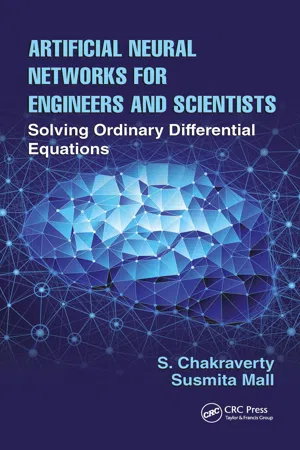
eBook - ePub
Artificial Neural Networks for Engineers and Scientists
Solving Ordinary Differential Equations
This is a test
- 150 pages
- English
- ePUB (mobile friendly)
- Available on iOS & Android
eBook - ePub
Artificial Neural Networks for Engineers and Scientists
Solving Ordinary Differential Equations
Book details
Book preview
Table of contents
Citations
About This Book
Differential equations play a vital role in the fields of engineering and science. Problems in engineering and science can be modeled using ordinary or partial differential equations. Analytical solutions of differential equations may not be obtained easily, so numerical methods have been developed to handle them. Machine intelligence methods, such as Artificial Neural Networks (ANN), are being used to solve differential equations, and these methods are presented in Artificial Neural Networks for Engineers and Scientists: Solving Ordinary Differential Equations. This book shows how computation of differential equation becomes faster once the ANN model is properly developed and applied.
Frequently asked questions
At the moment all of our mobile-responsive ePub books are available to download via the app. Most of our PDFs are also available to download and we're working on making the final remaining ones downloadable now. Learn more here.
Both plans give you full access to the library and all of Perlego’s features. The only differences are the price and subscription period: With the annual plan you’ll save around 30% compared to 12 months on the monthly plan.
We are an online textbook subscription service, where you can get access to an entire online library for less than the price of a single book per month. With over 1 million books across 1000+ topics, we’ve got you covered! Learn more here.
Look out for the read-aloud symbol on your next book to see if you can listen to it. The read-aloud tool reads text aloud for you, highlighting the text as it is being read. You can pause it, speed it up and slow it down. Learn more here.
Yes, you can access Artificial Neural Networks for Engineers and Scientists by S. Chakraverty, Susmita Mall in PDF and/or ePUB format, as well as other popular books in Mathematics & Applied Mathematics. We have over one million books available in our catalogue for you to explore.
Information
1
Preliminaries of Artificial Neural Network
This chapter addresses basics of artificial neural network (ANN) architecture, paradigms of learning, activation functions, and leaning rules.
1.1Introduction
Artificial neural network (ANN) is one of the popular areas of artificial intelligence (AI) research and also an abstract computational model based on the organizational structure of the human brain [1]. The simplest definition of ANN is provided by the inventor of one of the first neurocomputers, Dr. Robert Hecht-Nielsen. He defines a neural network as
a computing system made up of a number of simple, highly interconnected processing elements, which process information by their dynamic state response to external inputs.
ANNs are processing devices (algorithms) that are loosely modeled after the neuronal structure of the mammalian cerebral cortex but on much smaller scales. Computer scientists have always been inspired by the human brain. In 1943, Warren S. McCulloch, a neuroscientist, and Walter Pitts, a logician, developed the first conceptual model of an ANN [1]. In their paper, they describe the concept of a neuron, a single cell living in a network of cells that receives inputs, processes those inputs, and generates an output.
ANN is a data modeling tool that depends upon various parameters and learning methods [2,3,4,5,6,7,8]. Neural networks are typically organized in layers. Layers are made up of a number of interconnected “neurons/nodes,” which contain “activation functions.” ANN processes information through neurons/nodes in a parallel manner to solve specific problems. ANN acquires knowledge through learning, and this knowledge is stored within interneuron connections’ strength, which is expressed by numerical values called “weights.” These weights are used to compute output signal values for a new testing input signal value. Patterns are ...
Table of contents
- Cover
- Halftitle Page
- Title Page
- Copyright Page
- Contents
- Preface
- Acknowledgments
- Authors
- Reviewers
- 1. Preliminaries of Artificial Neural Network
- 2. Preliminaries of Ordinary Differential Equations
- 3. Multilayer Artificial Neural Network
- 4. Regression-Based ANN
- 5. Single-Layer Functional Link Artificial Neural Network
- 6. Single-Layer Functional Link Artificial Neural Network with Regression-Based Weights
- 7. Lane–Emden Equations
- 8. Emden–Fowler Equations
- 9. Duffing Oscillator Equations
- 10. Van der Pol–Duffing Oscillator Equation
- Index